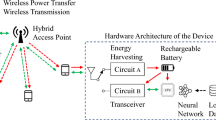Abstract
Federated learning (FL) is an emerging artificial intelligence (AI) basic technology. It is essentially a distributed machine learning (ML) that allows the client to perform model training locally and then upload the trained model parameters to the server while leaving the original data locally, which guarantees the client’s privacy and significantly reduces communication pressure. This paper combines non-orthogonal multiple access (NOMA) for optimizing bandwidth allocation and FL to study a novel energy-efficient FL system which can effectively reduce energy consumption under the premise of ensuring user privacy. The considered model uses clustering for transmission between clients and the base station (BS). NOMA is used inside the cluster to transmit information to BS, and frequency division multiple access (FDMA) is used between the clusters to eliminate the interference between the user clusters caused by the clustering. We combine communication and computing design to minimize the system’s total energy consumption. Since the optimization problem is non-convex, it is first transformed into a Lagrangian function, and the original problem is divided into three sub-problems. Then the Karush–Kuhn–Tucker (KKT) conditions and Successive Convex Approximation (SCA) method are used to solve each sub-problem. Simulation analysis shows that our proposed novel energy-efficient FL method design has significantly improved the performance compared with other benchmarks.






Similar content being viewed by others
Data availability
The data used to support the findings of this study are available from the corresponding author on reasonable request.
References
Lee, I., & Lee, K. (2015). The internet of things (IoT): Applications, investments, and challenges for enterprises. Business Horizons, 58(4), 431–440.
Li, S., Li, D. X., & Zhao, S. (2018). 5G internet of things: A survey. Journal of Industrial Information Integration, 10, 1–9.
Al-Fuqaha, A., Guizani, M., Mohammadi, M., et al. (2015). Internet of things: A survey on enabling technologies, protocols, and applications. IEEE Communications Surveys & Tutorials, 17(4), 2347–2376.
Rappaport, T. S., Shu, S., Mayzus, R., et al. (2013). Millimeter wave mobile communications for 5G cellular: It will work! IEEE Access, 1(1), 335–349.
Ding, Z., Peng, M., & Poor, H. V. (2015). Cooperative non-orthogonal multiple access in 5G systems. IEEE Communications Letters, 19(8), 1462–1465.
Zhang, X., Qian, G., Chen, G., et al. (2017). User grouping and power allocation for NOMA visible light communication multi-cell networks. IEEE Communications Letters, 21(4), 777–780.
Yu, S., Khan, W. U., Zhang, X., et al. (2021). Optimal power allocation for NOMA-enabled D2D communication with imperfect SIC decoding. Physical Communication, 46(3), 101296.
Li, H., Li, H., & Zhou, Y. (2021). Optimization algorithms for joint power and sub-channel allocation for NOMA-based maritime communications. Entropy, 23(11), 1454.
Choi, J. (2016). Power allocation for max-sum rate and max-min rate proportional fairness in NOMA. IEEE Communications Letters, 20(10), 2055–2058.
Kang, J. M., & Kim, I. M. (2018). Optimal user grouping for downlink NOMA. IEEE Wireless Communication Letters, 7(5), 724–727.
Islam, S., Avazov, N., Dobre, O. A., et al. (2017). Power-domain non-orthogonal multiple access (NOMA) in 5G systems: Potentials and challenges. IEEE Communications Surveys & Tutorials, 19(2), 721–742.
Liu, L., Zhang, J., Song, S. H., et al. (2020). Client-edge-cloud hierarchical federated learning. IEEE International Conference on Communications.
Sun, H., Ma, X., & Hu, R. Q. (2020). Adaptive federated learning with gradient compression in uplink NOMA. IEEE Transactions on Vehicular Technology, 3, 1–5.
Ye, D., Yu, R., Pan, M., et al. (2020). Federated learning in vehicular edge computing: A selective model aggregation approach. IEEE Access, 8, 23920–23935.
Li, T., Sahu, A. K., Talwalkar, A., et al. (2020). Federated learning: Challenges, methods, and future directions. IEEE Signal Processing Magazine, 37(3), 50–60.
Wu, H., Yi, S., & Wolter, K. (2020). Energy-efficient decision making for mobile cloud offloading. IEEE Transactions on Cloud Computing, 8(2), 570–584.
You, C., Zeng, Y., Zhang, R., et al. (2018). Asynchronous mobile-edge computation offloading: Energy-efficient resource management. IEEE Transactions on Wireless Communications, 17(11), 7590–7605.
Budhiraja, I., Kumar, N., Tyagi, S., et al. (2021). Energy consumption minimization scheme for NOMA-based mobile edge computation networks underlaying UAV. IEEE Systems Journal, 7, 1–10.
Liu, L., Sun, B., Tan, X., et al. (2021). Energy-efficient resource allocation and subchannel assignment for NOMA-enabled multiaccess edge computing. IEEE Systems Journal, 5, 1–12.
Karatalay, O., Psaromiligkos, I., & Champagne, B. (2022). Energy-efficient D2D-aided fog computing under probabilistic time constraints.
Zheng, Y., Ding, Z., Fan, P., et al. (2016). A general power allocation scheme to guarantee quality of service in downlink and uplink NOMA systems. IEEE Transactions on Wireless Communications, 15(11), 7244–7257.
Ming, Z., Yadav, A., Dobre, O. A., et al. (2017). Capacity comparison between MIMO-NOMA and MIMO-OMA with multiple users in a cluster. IEEE Journal on Selected Areas in Communications, 35(10), 2413–2424.
Funding
This work was financially supported by the Fundamental Research Funds for the Central Universities (No. CCNU20TS008) and the Graduate Education Innovation Project of Central China Normal University (No. 2022CXZZ105).
Author information
Authors and Affiliations
Corresponding author
Ethics declarations
Conflict of interest
The authors have no relevant financial or non-financial interests to disclose.
Additional information
Publisher's Note
Springer Nature remains neutral with regard to jurisdictional claims in published maps and institutional affiliations.
Rights and permissions
Springer Nature or its licensor (e.g. a society or other partner) holds exclusive rights to this article under a publishing agreement with the author(s) or other rightsholder(s); author self-archiving of the accepted manuscript version of this article is solely governed by the terms of such publishing agreement and applicable law.
About this article
Cite this article
Li, R., Zhang, G., Xu, H. et al. A Novel Energy-Efficient FL Resource Allocation Scheme Based on NOMA. Wireless Pers Commun 132, 2023–2040 (2023). https://doi.org/10.1007/s11277-023-10696-7
Accepted:
Published:
Issue Date:
DOI: https://doi.org/10.1007/s11277-023-10696-7




